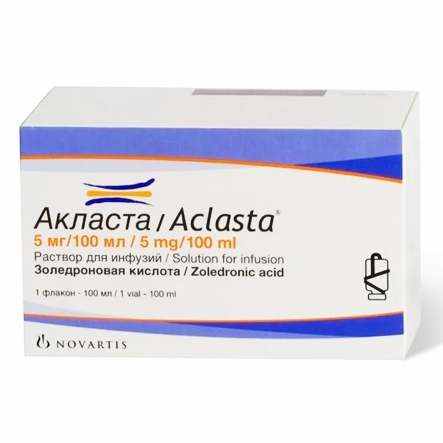
Uses
Zoledronic Acid is indicated in:
Hypercalcaemia of malignancy,
Bone metastases associated with solid tumours, Osteolytic lesions associated with multiple myeloma,
Corticosteroid-induced osteoporosis, Increase bone mass in men with osteoporosis, Osteoporosis in postmenopausal women
Paget's disease of bone
Prophylaxis of postmenopausal osteoporosis
Dosage
Hypercalcemia of malignancy: The maximum recommended dose of Zoledronic Acid in hypercalcemia of malignancy (serum calcium 12 mg/dl or 3.0 mmol/l) is 4 mg. The 4 mg dose must be given as a single-dose intravenous infusion. Dose adjustment of Zoledronic Acid is not necessary in treating patients for hypercalcemia of malignancy presenting with mild-to-moderate renal impairment. Re-treatment with Zoledronic Acid may be considered if serum calcium does not return to normal after initial treatment. It is recommended that a minimum of 7 days elapse before re-treatment, to allow for full response to the initial dose.Multiple myeloma and bone metastases of solid tumors: The recommended dose of Zoledronic Acid in patients with multiple myeloma and metastatic bone lesions from solid tumors is 4 mg infused every 3-4 weeks. Patients should also be administered an oral calcium supplement of 500 mg and 400 IU of Vitamin-D daily.
Prior to administration, the required amount of concentrate from one vial must be further diluted with 100 ml of calcium-free infusion solution (0.9% w/v sodium chloride solution or 5% w/v glucose solution). The duration of infusion must not be less than 15 minutes. After addition of the solution to the infusion media, the infusion solution should be used as soon as possible. If storage of the infusion solution is necessary, hold at 2-8º C for not more than 24 hours. If refrigerated, the solution must be allowed to reach room temperature before administration.Zoledronic Acid must not be mixed with calcium or other divalent cation-containing infusion solutions, such as Lactated Ringer's solution, and should be administered as a single intravenous solution in a line separate from all other drugs.
Side Effects
The post-dose side-effects are headache, nausea, anorexia, fatigue, osteonecrosis of jaw, anemia, bone pain, constipation, fever, vomiting, flu-like syndrome, hypocalcemia, myalgia, arthralgia and hypophosphataemia.
See simplified version
Aclasta 5 mg/100 ml IV Infusion also
Aclasta 5 mg/100 ml IV Infusion in bangla
Precaution
Patients must be appropriately hydrated prior to administration of Zoledronic Acid. This is especially important in the elderly and for patients receiving diuretic therapy. Adequate hydration can be achieved by the patient drinking two glasses of fluid (such as water) before and after the infusion. Serum levels of calcium, phosphate, magnesium and potassium, as well as serum creatinine should be carefully monitored after initiating Zoledronic Acid therapy. If hypocalcemia, hypophosphatemia or hypomagnesemia occurs, short-term supplemental therapy may be necessary. Moreover, careful renal function monitoring should be considered.
Interaction
In clinical studies, Zoledronic acid has been administered concomitantly with commonly used anticancer agents, diuretics, antibiotics and analgesics without interactions. Caution is advised when Zoledronic acid are administered with aminoglycosides, since these agents may have an additive effect to lower serum calcium level for prolonged periods. In multiple myeloma patients, the risk of renal dysfunction may be increased when Zoledronic acid is used in combination with thalidomide. Concomitant use of loop diuretics with Zoledronic acid increases the risk of hypocalcemia. Caution is indicated when Zoledronic acid is used with other potentially nephrotoxic drugs.
Pregnancy & Breastfeeding use
Zoledronic acid is contraindicated during pregnancy and in breast-feeding women. It is also not recommended for use in children and adolescents below 18 years of age.
Contraindication
The drug is contraindicated if patients have hypersensitivity to the active substance or to any of the excipients or to any bisphosphonates; severe renal impairment (Creatinine clearance <30 ml/min); pregnancy and lactation.
Special Warning
Patients with renal impairment: The use of Zoledronic Acid is not recommended in patients with severe renal impairment (Creatinine clearance <30 ml/min). No dose adjustment is necessary in patients with creatinine clearance >60 ml/min. Based on creatinine clearance the following dose should be used in patient with impaired renal function:
CrCl > 60 ml/min: 4 mg (5 ml)
CrCl 50-60 ml/min: 3.5 mg (4.4 ml)
CrCl 40-49 ml/min: 3.3 mg (4.1 ml)
CrCl 30-39 ml/min: 3 mg (3.8 ml)
Acute Overdose
Clinical experience with acute over dosage is limited. Over dosage may cause hypocalcemia, hypophosphatemia, and hypomagnesemia. In such case, reduction in serum levels of calcium, phosphorus, and magnesium should be corrected by intravenous administration of calcium gluconate, potassium or sodium phosphate and magnesium sulfate respectively.
Storage Condition
Store below 30° C prior to opening. Protect from moisture and light. Zoledronic Acid must be kept out of the reach and sight of children.
Innovators Monograph




